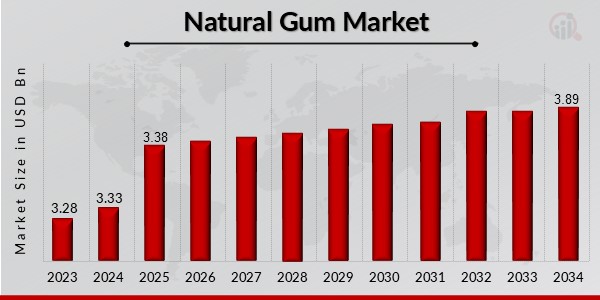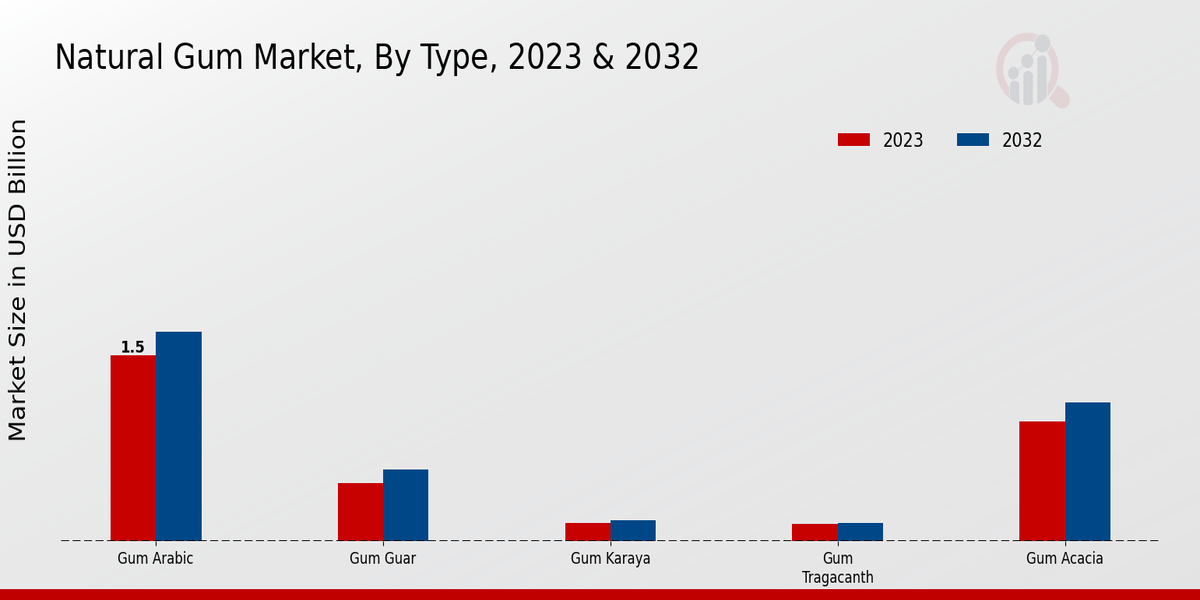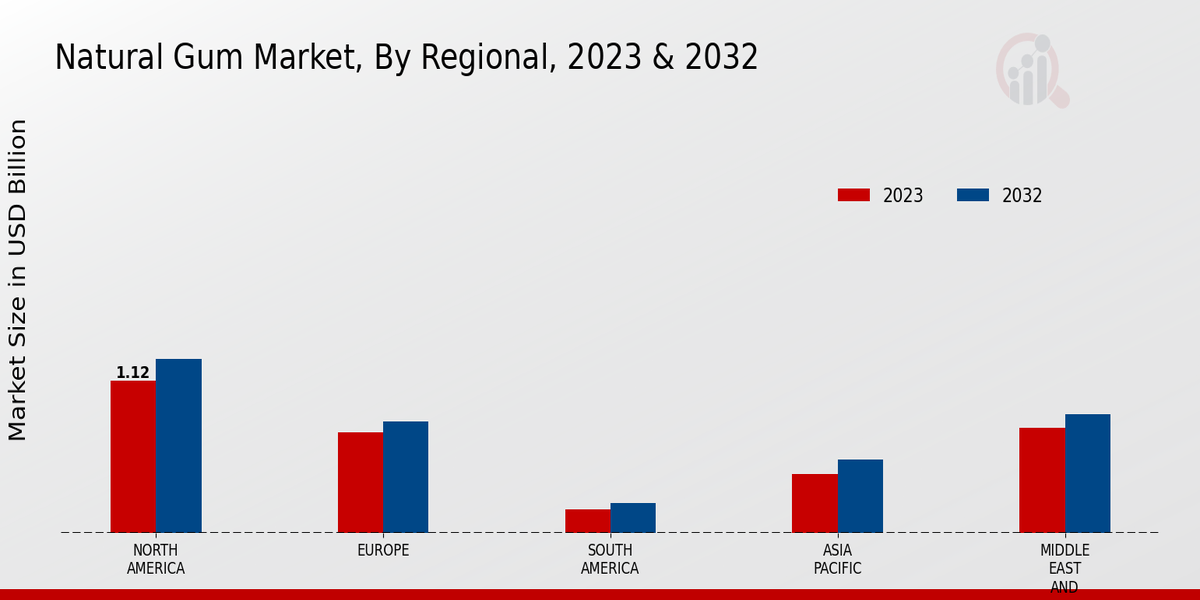Global Natural Gum Market Overview
Natural Gum Market Size was estimated at 3.33 (USD Billion) in 2024. The Natural Gum Industry is expected to grow from 3.38(USD Billion) in 2025 to 3.89 (USD Billion) by 2034. The Natural Gum Market CAGR (growth rate) is expected to be around 1.6% during the forecast period (2025-2034).

Source: Primary Research, Secondary Research, Market Research Future Database and Analyst Review
Key Natural Gum Market Trends Highlighted
The natural gum market is flourishing as there is an increase in the appetite for a variety of natural products, including those emerging from the food and beverage and pharmaceutical industries. In today's world, the trend is such that individuals are becoming more sensitive about their health and thus looking out for products that do not have or have very small portions of synthetics. Plants-based natural gums have the required thickness, stability, and gel characteristics, hence meeting this rising demand.
Further opportunities for this market are expected to be attributed to the wider usage of natural gums across several industries, including food, cosmetics, and pharmaceuticals. New techniques of extracting and purifying the natural gums will enhance the supply and quality of the natural gums which will support the growth of this market.
Some of the current changes that are taking place within the natural gum market tend towards resourcing in more diversity with gum sources where the manufacturers seeking alternative sources are taking, e.g., algae and microorganisms. Focus is also shifting towards sustainability, especially on the use of eco-friendly processes to extract the gum as well as the promotion of sustainable agriculture of the gum producing plants. In addition, the use of other modern technologies like nanotechnology is also improving the properties and uses of natural gum.
Natural Gum Market Drivers
Increasing Demand for Natural and Organic Products
Consumers are increasingly seeking natural and organic products due to concerns about the safety and environmental impact of synthetic ingredients. This trend is expected to continue to drive demand for natural gums, which are derived from plants and are perceived as being more sustainable and healthier than synthetic alternatives. The Natural Gum Market Industry is witnessing a rise in demand for natural and organic food products.
This increasing demand can be attributed to the growing health consciousness among consumers, who are now more aware of the harmful effects of synthetic ingredients and chemicals.As a result, they are opting for natural and organic products that are free from artificial additives and preservatives. This trend is expected to continue in the coming years, which will propel the growth of the Natural Gum Market Industry.
Rising Demand from the Food and Beverage Industry
The food and beverage industry is a major consumer of natural gums, which are used as thickeners, stabilizers, and emulsifiers. The growing demand for processed and packaged foods is expected to drive demand for natural gums in the coming years. The Natural Gum Market Industry is also witnessing a rise in demand from the food and beverage industry. This increasing demand can be attributed to the growing popularity of processed and packaged foods, which require natural gums as thickeners, stabilizers, and emulsifiers.Natural gums help in improving the texture, consistency, and shelf life of food products.
As the demand for processed and packaged foods continues to rise, the demand for natural gums is also expected to increase.
Expanding Applications in the Pharmaceutical and Cosmetic Industries
Natural gums are becoming increasingly popular in the pharmaceutical and cosmetic industries. In the pharmaceutical industry, they are used as binders, disintegrants, and controlled-release agents, while the cosmetic industry uses them as thickeners, stabilizers, and emulsifiers. Natural gums are expected to become more widely demanded in the upcoming years because of the growing popularity of natural and organic personal care products.
The Natural Gum Market Industry is anticipated to witness significant growth because of the growing demand for them from the pharmaceutical and cosmetic industries.In the pharmaceutical industry, they are used as binders, disintegrants, and controlled-release agents, while in the cosmetic industry, they are used as emulsifiers, stabilizers, and thickeners. The growing popularity of natural and organic personal care products should also fuel their demand in the upcoming years
Natural Gum Market Segment Insights
Natural Gum Market Type Insights
The Natural Gum Market is segmented by type into Gum Arabic, Gum Guar, Gum Karaya, Gum Tragacanth, and Gum Acacia. Gum Arabic is the most dominant segment, accounting for over 40% of the global market share in 2023. It is majorly used in the food and beverage industry as a stabilizer, emulsifier, and thickener. The increasing demand for natural and organic ingredients in food and beverages is a prime driver of the growth of the Gum Arabic market. Gum Guar significantly propels market growth, with a share of about 25% in 2023.
Guar gum is primarily used as a thickening agent in food and beverages and oil and gas drilling fluids.The demand for guar gum in the oil and gas industry is rising and is expected to propel the growth of the Gum Guar segment. The Gum Karaya market can also be considered a significant segment as it has a share of about 10% in 2023. It is used in food and beverages, pharmaceuticals, and cosmetics. The Gum Tragacanth and Gum Acacia market situation is similar to that of Gum Karaya.
The prime drivers of the market are the demand for natural and organic ingredients, increasing consumption of processed foods and beverages, and increased use of natural gum in pharmaceuticals and cosmetics.

Source: Primary Research, Secondary Research, Market Research Future Database and Analyst Review
Natural Gum Market Applications Insights
The Natural Gum Market segmentation by Applications is expected to witness significant growth in the coming years. In 2023, the Food and Beverages segment held the largest market share, accounting for nearly half of the Natural Gum Market revenue. The increasing demand for natural and healthy food and beverage products is driving the growth of this segment. The Pharmaceuticals segment is also expected to witness steady growth, driven by the increasing use of natural gums in drug formulations and excipients.
The Cosmetics segment is another promising segment, with natural gums being used in various skincare and haircare products.The Industrial segment is expected to witness moderate growth, with natural gums being used in adhesives, paints, and coatings. The Papermaking segment is also expected to witness steady growth, with natural gums being used as binders and thickeners in paper production.
Natural Gum Market Extraction Method Insights
The extraction method segment plays a crucial role in the Natural Gum Market, with each method offering unique advantages and drawbacks. Natural gum extraction methods can be categorized into three main types: natural, semi-synthetic, and synthetic. Natural extraction involves harvesting gum directly from plants, while semi-synthetic methods modify the natural gum to enhance its properties. Synthetic gums, on the other hand, are produced entirely through chemical synthesis.
In 2023, the natural extraction method dominated the Natural Gum Market, accounting for over 65% of the revenue share.This dominance can be attributed to the high demand for natural and organic ingredients in various industries, including food, beverages, and pharmaceuticals. Semi-synthetic gums held a significant market share of around 20%, primarily driven by their improved functionality and stability compared to natural gums. Synthetic gums accounted for the remaining market share, with their use concentrated in specific applications where high consistency and purity are required.
Over the forecast period, the natural extraction method is expected to continue its dominance, driven by the increasing consumer preference for natural and eco-friendly products.However, semi-synthetic and synthetic gums are projected to gain market share due to their superior properties and cost-effectiveness in certain applications.
Natural Gum Market Grade Insights
The Natural Gum Market segmentation by Grade comprises Pharmaceutical Grade, Food Grade, Industrial Grade, and Cosmetic Grade. Among these, the food-grade segment held the largest market share in 2023, accounting for over 45% of the Natural Gum Market revenue. The increasing demand for natural and healthy ingredients in the food industry is driving the growth of this segment. The Pharmaceutical Grade segment is also expected to witness significant growth during the forecast period, owing to the rising prevalence of chronic diseases and the increasing demand for natural and herbal remedies.
Natural Gum Market Regional Insights
The regional segmentation of the Natural Gum Market offers valuable insights into the diverse market dynamics across different regions. North America holds a significant market share, driven by the increasing demand for natural gums in food and beverage applications. Europe follows closely, with a strong presence in the confectionery and pharmaceutical industries. APAC is anticipated to experience substantial growth due to the rising population and growing disposable income.
South America and MEA are emerging markets with promising growth potential, attributed to the expanding food and beverage sector.By understanding the regional market dynamics, businesses can tailor their strategies to capture opportunities and address challenges in each region effectively. With a projected market size of USD 3.72 billion in 2032, the Natural Gum Market presents lucrative growth prospects for key players in the industry.

Source: Primary Research, Secondary Research, Market Research Future Database and Analyst Review
Natural Gum Market Key Players And Competitive Insights
The increasing demand for natural and organic ingredients in food, beverages, and personal care products is a major driver for the development of the Natural Gum Market. Major players are adopting various strategies such as mergers and acquisitions, product launches, and collaboration to expand their market presence. Leading players in the Natural Gum Market are heavily investing in research and development to introduce innovative products for the varying requirements of end-users.
Cargill, Incorporated is a prominent company operating in the Natural Gum Market. The company offers a wide range of natural gum products, such as guar gum, locust bean gum, xanthan gum, and gum Arabic. It is headquartered in the United States and has a strong presence in Europe, North America, and Asia-Pacific. Cargill is focusing on the expansion of its product portfolio and production capacity to cope with the increasing demand for natural gums.
Ingredion Incorporated is another significant player operating in the Natural Gum Market. The company is headquartered in the United States and offers natural gums, including guar gum, locust bean gum, xanthan gum, and Arabic gum. Ingredion has a strong presence in North America, South America, and Europe. The company is focusing on innovation and sustainability to preserve its position in the market.
Key Companies in the Natural Gum Market Include
- Archer Daniels Midland Company
- Sensient Technologies Corporation
Natural Gum Market Industry Developments
The Natural Gum Market is projected to reach USD 3.72 billion by 2032, exhibiting a CAGR of 1.56% during the forecast period (2024-2032). Rising demand for natural and clean-label ingredients in food and beverages, coupled with increasing consumer awareness regarding the health benefits of natural gums, is primarily driving market growth.Recent developments in the market include the launch of new products, such as acacia gum-based prebiotic fibers and gellan gum-based vegan cheese, catering to the growing demand for plant-based alternatives. Additionally, strategic acquisitions and partnerships between key players are shaping the market landscape.
For instance, in 2023, Ingredion Incorporated acquired Penford Corporation, a leading provider of natural gums, to strengthen its portfolio and expand its global reach.
Natural Gum Market Segmentation Insights
-
Natural Gum Market Type Outlook
-
Natural Gum Market Applications Outlook
-
Natural Gum Market Extraction Method Outlook
-
Natural Gum Market Grade Outlook
-
Natural Gum Market Regional Outlook
-
Europe
-
South America
-
Asia-Pacific
| Report Attribute/Metric |
Details |
| Market Size 2024 |
3.33(USD Billion) |
| Market Size 2025 |
3.38(USD Billion) |
| Market Size 2034 |
3.89(USD Billion) |
| Compound Annual Growth Rate (CAGR) |
1.6% (2025 - 2034) |
| Report Coverage |
Revenue Forecast, Competitive Landscape, Growth Factors, and Trends |
| Base Year |
2023 |
| Market Forecast Period |
2025 - 2034 |
| Historical Data |
2019 - 2022 |
| Market Forecast Units |
USD Billion |
| Key Companies Profiled |
D.D. Williamson, Lonza, Gum Technology, Symrise, Cargill, CP Kelco, Tate Lyle, Ashland, Archer Daniels Midland Company, Firmenich, DuPont, Sensient Technologies Corporation, Kerry, Palsgaard, Ingredion Incorporated |
| Segments Covered |
Type, Applications, Extraction Method, Grade, Regional |
| Key Market Opportunities |
Growing food and beverage industry Rising demand for natural ingredients Health and wellness trend Technological advancements Expanding application areas |
| Key Market Dynamics |
Rising demand for natural ingredients Increasing health consciousness Growing applications in various industries Entry of new players Advances in extraction and processing technologies |
| Countries Covered |
North America, Europe, APAC, South America, MEA |
Frequently Asked Questions (FAQ):
The Natural Gum Market size was valued at 3.38 billion USD in 2025 and is projected to expand at a compound annual growth rate (CAGR) of 1.6% from 2025 to 2034.
Asia-Pacific held the largest market share in 2025, accounting for over 40% of the global market. North America and Europe are other significant regions in the natural gum market.
The food and beverage industry is the largest consumer of natural gum, accounting for around 60% of the total demand. Other major end-use industries include pharmaceuticals, personal care, and industrial applications.
Rising demand for natural and clean-label ingredients, increasing consumption of processed foods, and growing health consciousness among consumers are the primary drivers of the natural gum market.
Key players in the natural gum market include Archer Daniels Midland Company, Cargill, Incorporated, Ingredion Incorporated, and Tate Lyle PLC.
Natural gums can be classified into various types based on their sources, such as plant exudates (e.g., gum arabic, gum tragacanth), seed gums (e.g., guar gum, locust bean gum), and microbial gums (e.g., xanthan gum, gellan gum).
The natural gum market is anticipated to witness steady growth over the forecast period. Factors such as increasing urbanization, changing dietary patterns, and expanding applications in various industries are expected to contribute to market growth.
Fluctuating raw material prices, supply chain disruptions, and regulatory compliance can pose challenges to the natural gum industry.
Companies can capitalize on the growth opportunities by focusing on product innovation, expanding their geographical presence, and strengthening their distribution channels.
Sustainability, transparency, and clean-label formulations are emerging trends in the natural gum market. Consumers are increasingly seeking products made with natural and ethically sourced ingredients.

















